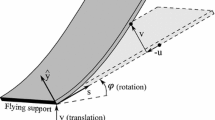Abstract
At low Reynolds numbers, the variable flexibility of flapping insect wings is considered essential in improving the favorable aerodynamic forces. To further explore whether significant aerodynamic coupling exists between the microstructure and passive flexible deformation, this paper proposes three technical comparison airfoils: a corrugated wing with deformation, a symmetric flat plate wing with deformation, and a corrugated wing without deformation. Based on STAR-CCM+ software, this paper numerically solves the Navier-Stokes equations using the fluid-structure interaction method. The results show that the aerodynamic performance of the flexible corrugated wing is better than that of the rigid corrugated wing, and its lift and thrust are both improved to a certain extent, and the thrust efficiency of the flexible corrugated wing is significantly higher than that of the flexible flat plate. Although the thrust is improved, a part of the lift is lost, and as the flapping amplitude increases past 35°, the disparity gradually increases. A comparison of the flexible technical airfoils shows that the corrugated structure promotes thrust and retards lift, which is closely related to the formation and dissipation of strong vortex rings during the downstroke phase. On the premise of maintaining typical flapping without falling, dragonflies can fly with skillful efficiency by adjusting the way they flap their wings. The results of this work provide new insight into the formation and role of thrust in flapping maneuvering flight and provide a specific reference for developing new bionic flapping-wing aircraft.

摘要
在低雷诺数下, 拍动昆虫翅膀的可变灵活性被认为是提高有利空气动力的必要条件. 为了进一步探讨微结构与被动柔性变形之间是否存在显著的气动耦合, 本文提出了三种技术对比翼型: 变形的波纹翼、变形的对称平板翼和无变形的波纹翼. 本文基于STAR-CCM+软件, 采用流固耦合法对Navier-Stokes方程进行数值求解. 结果表明, 柔性波状翼的气动性能优于刚性波状翼, 其升力和推力均有一定程度的提高, 柔性波纹翼的推力效率明显高于柔性平板翼. 虽然推力提高了, 但也损失了一部分升力, 随着扑动幅度增加超过35°, 差距逐渐增大. 柔性技术翼型的对比表明, 褶皱结构促进推力并阻滞升力, 这与下冲程阶段强涡环的形成和消散密切相关.蜻蜓在保持典型的拍打不坠落的前提下, 通过调整拍打翅膀的方式, 可以高效地飞行. 该工作成果为扑翼机动飞行中推力的形成和作用提供了新的认识, 为研制新型仿生扑翼飞行器提供了具体参考.
Similar content being viewed by others
References
C. P. Ellington, The aerodynamics of hovering insect flight. I. The quasi-steady analysis, Phil. Trans. R. Soc. Lond. B 305, 1 (1984).
C. P. Ellington, The aerodynamics of hovering insect flight. II. Morphological parameters, Phil. Trans. R. Soc. Lond. B 305, 17 (1984).
Y. H. Chen, M. Skote, Y. Zhao, and W. M. Huang, Dragonfly (Sympetrum flaveolum) flight: Kinematic measurement and modelling, J. Fluids Struct. 40, 115 (2013).
D. Iverson, M. Rahimpour, W. Lee, T. Kiwata, and P. Oshkai, Effect of chordwise flexibility on propulsive performance of high inertia oscillating-foils, J. Fluids Struct. 91, 102750 (2019).
Y. F. Zhang, Z. Y. Ye, F. Xie, The numerical analysis of the reason for the effect of spanwise flexibility on flapping wing thrust (in Chinese), J. Eng. Mech. 30, 419 (2013).
J. Fu, X. Liu, W. Shyy, and H. Qiu, Effects of flexibility and aspect ratio on the aerodynamic performance of flapping wings, Bioinspir. Biomim. 13, 036001 (2018).
C. J. C. Rees, Aerodynamic properties of an insect wing section and a smooth aerofoil compared, Nature 258, 141 (1975).
C. J. C. Rees, Form and function in corrugated insect wings, Nature 256, 200 (1975).
A. B. Kesel, Aerodynamic characteristics of dragonfly wing sections compared with technical aerofoils, J. Exp. Biol. 203, 3125 (2000).
G. Luo, and M. Sun, The effects of corrugation and wing planform on the aerodynamic force production of sweeping model insect wings, Acta Mech. Sin. 21, 531 (2005).
G. Du, and M. Sun, Aerodynamic effects of corrugation and deformation in flapping wings of hovering hoverflies, J. Theor. Biol. 300, 19 (2012).
X. G. Meng, L. Xu, and M. Sun, Aerodynamic effects of corrugation in flapping insect wings in hovering flight, J. Exp. Biol. 214, 432 (2011).
J. H. Wu, and M. Sun, Unsteady aerodynamic forces of a flapping wing, J. Exp. Biol. 207, 1137 (2004).
M. Sun, and J. Tang, Unsteady aerodynamic force generation by a model fruit fly wing in flapping motion, J. Exp. Biol. 205, 55 (2002).
Y. Luo, G. Y. He, Q. Wang, H. Song, and D. H. Chen, Effect of fold structure on aerodynamic characteristics of dragonfly hind wing (in Chinese), J. Adv. Aeronaut. Eng. 10, 355 (2019).
Y. Luo, G. He, H. Liu, Q. Wang, and H. Song, Aerodynamic performance of dragonfly forewing-hindwing interaction in gliding flight, IOP Conf. Ser.-Mater. Sci. Eng. 538, 012048 (2019).
H. Song, G. Y. He, Q. Wang, and L. S. Chen, Numerical study on the aerodynamic performance of the rigid and corrugated forewing of dragonfly in flapping flight, IOP Conf. Ser.-Mater. Sci. Eng. 816, 012005 (2020).
L. B. Meng, H. S. Ang, T. H. Xiao, Analysis of aerodynamic characteristics of flexible wing of dragonfly based on CFD/CSD method (in Chinese), J. Aerosp. Power. 29, 2063 (2014).
H. Wang, L. Zeng, H. Liu, and C. Yin, Measuring wing kinematics, flight trajectory and body attitude during forward flight and turning maneuvers in dragonflies, J. Exp. Biol. 206, 745 (2003).
J. S. Huang, G. Y. He, Q. Wang, Aerodynamic efficiency analysis of dragonfly flexible hind wing model, Sci. Technol. Eng. 21, 5133 (2021).
K. N. Lucas, P. J. M. Thornycroft, B. J. Gemmell, S. P. Colin, J. H. Costello, and G. V. Lauder, Effects of non-uniform stiffness on the swimming performance of a passively-flexing, fish-like foil model, Bioinspir. Biomim. 10, 056019 (2015).
Acknowledgements
This work was supported by the National Natural Science Foundation of China (Grant No. 11862017). The calculations were performed on Jinan Supercomputer, the National Supercomputer Center of Beijing Parallel Science and Technology.
Author information
Authors and Affiliations
Corresponding author
Rights and permissions
About this article
Cite this article
Wang, Y., He, X., He, G. et al. Aerodynamic performance of the flexibility of corrugated dragonfly wings in flapping flight. Acta Mech. Sin. 38, 322038 (2022). https://doi.org/10.1007/s10409-022-22038-x
Received:
Accepted:
Published:
DOI: https://doi.org/10.1007/s10409-022-22038-x



